Messerschmitt Bf 108
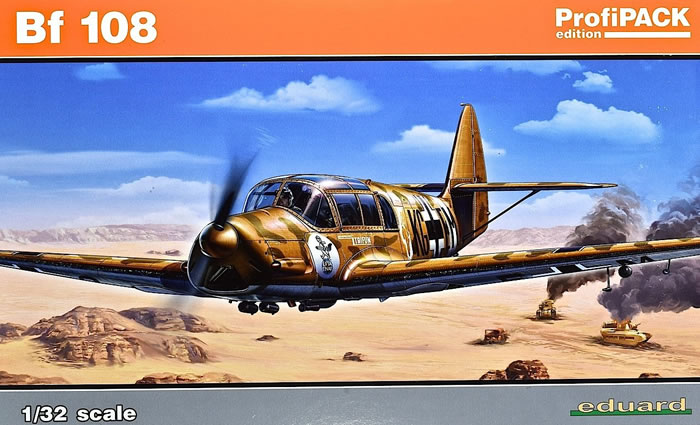
Eduard, 1/32 scale
S
u m m a r y : |
Description and Item No.: |
Eduard Kit No. 3006 - Messerschmitt Bf 108 |
Contents and Media: |
124 parts in grey styrene, 9 in clear, propeller and hub in resin, color photo-etch, masks, and one decal sheet with markings for 5 airframes. |
Price: |
USD$64.95 plus shipping available online from Eduard's web store
GBP£32.58 EU Price (£27.15 Export Price) Plus Shipping at Hannants |
Scale: |
1/32 |
Review Type: |
First Look |
Advantages: |
Low parts count should be a straightforward build; beautiful color photo-etch; high quality decals. |
Disadvantages: |
Fabric effect on the control surfaces is lacking; wheel detail is a bit soft. |
Recommendation: |
This kit features nicely done, recessed surface details and all the major parts exhibit good fit right off the sprues. There’s no doubt it will build into a beautiful model but to get the most out of this kit a little extra elbow grease may be required. |
Reviewed by John Miller

Airfix's 1/72 scale Sea King is available online from Squadron.com
The Messerschmitt Bf 108 Taifun (Typhoon) was a German single-engine sport and touring aircraft of all-metal construction, developed by Bayerische Flugzeugwerke in the 1930s.
Design and Development
Originally designated the M37, the aircraft was designed as a four-seat sports/recreation aircraft for competition in the 4th Challenge International de Tourisme (1934). The M37 prototype flew first in the spring of 1934, powered by a 250 PS (247 hp, 184 kW) Hirth HM 8U 8.0 litre displacement, air-cooled inverted-V8 engine driving a three-blade propeller.
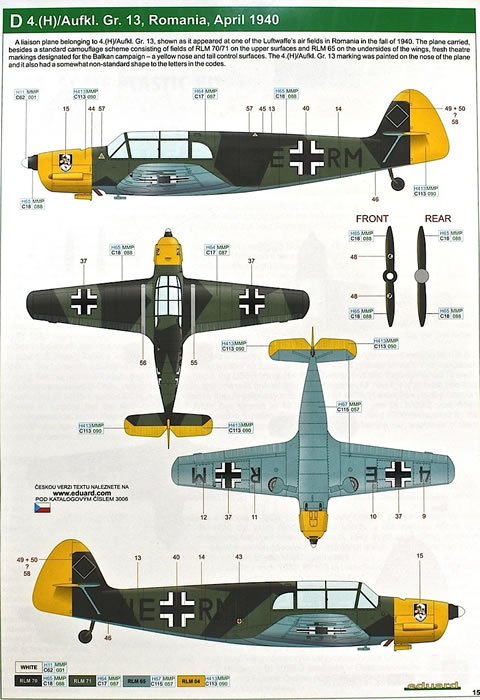
Although it was outperformed by several other aircraft in the competition, the M37's overall performance marked it as a popular choice for record flights. Particular among these traits was its low fuel consumption rate, good handling, and superb takeoff and landing characteristics.
The Bf 108 A first flew in 1934, followed by the Bf-108B in 1935. The Bf-108B used the substantially larger, 12.67 litre displacement Argus AS-10 air-cooled inverted V8 engine. The nickname Taifun (Typhoon) was given to her own aircraft by Elly Beinhorn, a well-known German pilot, and was generally adopted.
Operational History
Soon after the first production aircraft began to roll off the assembly line in Augsburg, several Bf-108s had set endurance records.
The Bf 108 was adopted into Luftwaffe service during World War II, where it was primarily used as a personnel transport and liaison aircraft. Production of the Bf 108 was transferred to occupied France during World War II and continued after the war as the Nord 1000 Pingouin.
(Edited from Wikipedia)
This is a reboxing of the "Striped Fighter" 1/32 scale Bf 108 Taifun released in 2018.
Eduard's version of the kit comprises 124 parts in grey styrene, 9 in clear, propeller and hub in resin, color photo-etch, masks, and one decal sheet with markings for 5 airframes.
Each sprue is separately bagged as are the photo-etched fret, masks, and decals.
The first impression is one of size; this will be a pretty big model when complete. There’s very little flash and the recessed panel lines are scale appropriate. The fasteners on both the cowl and wing fillets are also nicely inscribed but a bit soft in execution.
A notable feature is the slightly pebbly texture present on the entirety of the model's external surface that some may find less than desirable. This is especially true if you contemplated finishing your 108 in a natural metal finish.

Bear in mind this textured surface will serve as a great substrate for a primer coat that, with a little buffing, will provide a sufficiently smooth finish for paint and decals. I suspect the textured surfaces will cause little extra work as similar textures have been used by other manufactures to good effect. If, however, you’re bent on doing a 108 in natural metal, be prepared to do a bit of sanding.
Assembly begins with the cockpit, and there is ample detail here right out of the box. This is a good thing as the Taifun is graced with a rather large canopy so a lot will be seen when the model is complete whether the canopy is posed open or closed.
Two different sized gas tanks are provided for the rear seat that are scheme-specific so be sure to study the plans before committing with glue.
The color PE instrument panel as well as seat harnesses provided for both crew (2) and passengers (2) will really jazz up the cockpit. The assembled cockpit tub (complete with nicely detailed side panels) is then set aside and the builder is directed to assemble the Argus 8-cylinder engine. The engine, complete with its mount, exhausts, and accessories is well detailed and much of this assembly will be visible through the nose cowl.
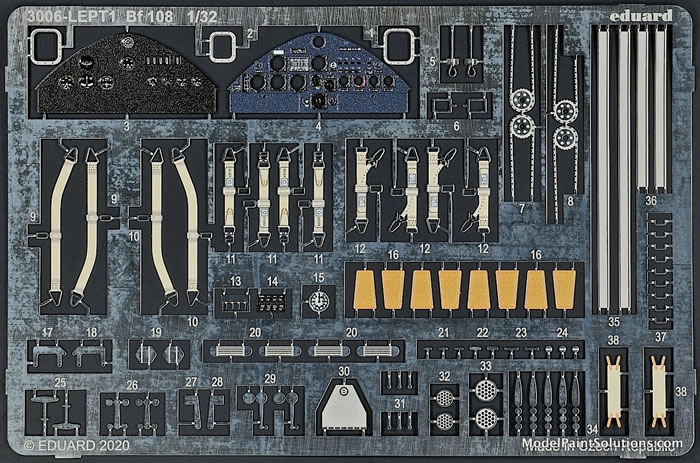
Opening the engine access panels on each side of the nose is not an option.
Next in sequence is the large instrument panel, which can be assembled from a plastic panel and nicely printed decal or from the beautiful, color photo-etch version also provided. The panel and engine are then trapped between the fuselage halves and the completed cockpit tub is offered up through the bottom of the fuselage completing the assembly.
The propeller is supplied as a resin part with a separate spinner cap.
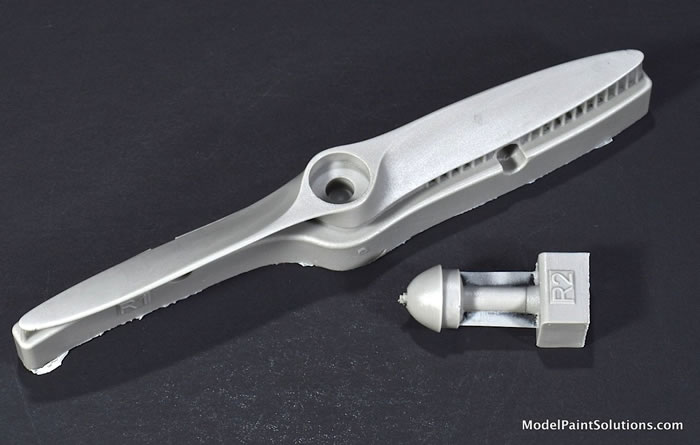
The empennage is comprised of halved horizontal stabilizers and elevators, which are poseable. Similarly, the two different scheme-specific rudders (one with a balance horn) are composed of halves, and are also poseable as are the ailerons and flaps.
With this many fabric-covered control surfaces the replication of taught fabric and rib tapes is of some importance. Unfortunately the kit is a bit of a let down here as there are no rib tapes present and the fabric effect on the control surfaces is minimal. Adding some of these details is doable but will require extra effort.
The wing, composed of a full-span lower half with left and right upper halves, is next in sequence. Once completed its offered up to the fuselage thereby completing the majority of the assembly.
Both spoked and covered wheels are provided that are scheme-specific. The wheels are sufficiently detailed although the spoked version seems a bit soft in execution. Eduard has addressed this with a nice resin aftermarket set of wheels. The gear doors are nicely molded with good detail but have small ejector pin marks that will have to be dealt with.
The canopy parts are crystal-clear and crisply molded with scale-appropriate framing.

The rows of fasteners running along the canopy framing are especially well done. A one-piece closed canopy is provided, as are all of the parts required to pose both hinged doors open. Various details such as canopy latches, handles, and levers are provided in PE. Masks are provided for both the canopy ad the wheels.
Markings:
The decals, by Eduard, are crisply printed with good color density and registration.
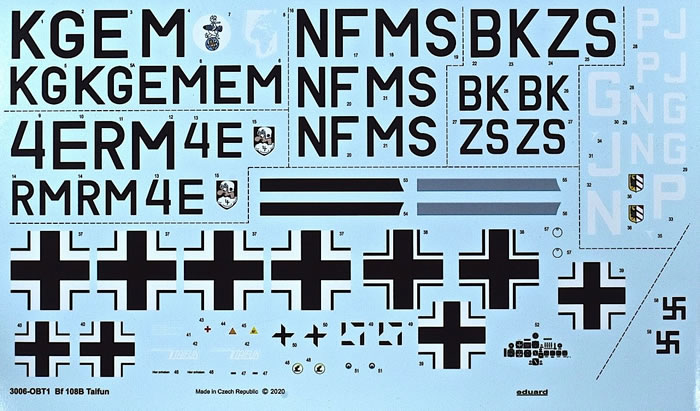
Markings for 5 airframes are provided as follows:
A) Sonderkommando Blaich, Tripoli, January 1942.
B) Hungary, 1942-44.
C) StabI./JG51, Soviet Union, Winter, 1942-43.
D) 4.(H)/Aufkl.GR 13, Romania, April 1940.
E) I/JG 54, France, June/July 1940.
This kit features nicely done, recessed surface details and all the major parts exhibit pretty good fit right off the sprues. The one let down is the fabric-covered control surface details.
There’s no doubt it will build into a beautiful model but to get the most out of this kit a little extra elbow grease may be required. That said the result will be a beautifully detailed model of a very nice looking airplane.
Recommended!
For more on this review visit Modelpaintsolutions.com.
Review kit provided by my retirement fund, again.
Review Text and Images Copyright © 2020 by John Miller
Page Created 29 May, 2020
Last updated
29 May, 2020
Back to HyperScale Main Page
Back to Reviews Page

|
Home
| What's New |
Features |
Gallery |
Reviews |
Reference |
Forum |
Search